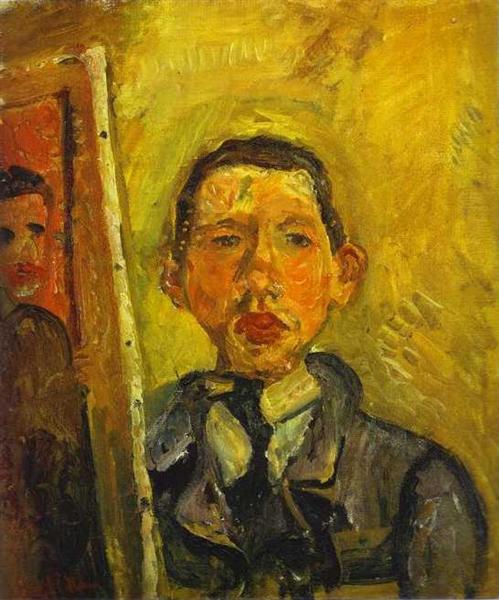Beskrivelse
The painting "Self-portrait - 1918" by Chaim Soutine is a work that radiates emotional intensity and deep introspection, distinctive features of the author's style. Soutine, a prominent representative of expressionism and fauvism, is known for his way of translating the inner turmoil and complexity of human existence through painting. In this self-portrait, Soutine gives us not only an image of his own face, but also a disturbing insight into his psyche at a critical moment in his life.
Looking at the composition of the work, the first thing that strikes you is the strength of the gestures. The brushwork is energetic and almost visceral, a trait that Soutine masterfully employs to convey his emotions. The painting features a dark background that encloses the sitter in a kind of isolation; this choice of a sombre setting creates a powerful contrast that makes the artist’s face even more prominent. The light falls on his figure selectively, illuminating his face dramatically, suggesting both vulnerability and strength.
The colour palette is another standout feature in this self-portrait. Soutine opts for a bold use of tones, where warm yellows, muted greens and brown hues that seem to pulsate with life predominate. This colour choice is not only a representation of her figure, but also seems to evoke emotional states: the darker colours reflect the shadow of despair, while the highlights seem to yearn for some kind of hope. The combination of these elements gives the work a tumultuous energy, almost as if the canvas could vibrate with the artist’s emotions.
As for facial features, Soutine portrays herself with an intense gaze that penetrates the viewer’s emotion. Her eyes, even in a seemingly distorted and almost cartoonish representation, communicate a story of suffering and introspection. This almost abstract approach to the human figure, so characteristic of Soutine, reflects her rejection of the norms of traditional portraiture in order to delve into more disturbing and meaningful psychological territory. The distortion of proportions and form highlights her desire to go beyond mere physical representation, seeking to capture the essence of her inner self.
The context of the creation of this work is relevant. Painted in 1918, the author was in a tumultuous period, marked by post-war instability and personal struggle, which is reflected in the anxiety and melancholy of the self-portrait. Soutine, who had been a pioneer of expressionism, uses his technique to address themes of identity and suffering, turning his own face into a mirror of human pain. This search for authenticity through deformation and the emotive use of colour places him in a line of continuity with other artists of his time, but also establishes his distinctive recognition.
“Self-Portrait – 1918” is ultimately a testament to Chaim Soutine’s turbulent interiority. With his skillful handling of color and brush, he transforms what could have been a simple representation into a profound emotional dialogue. This work invites observers not only to contemplate the artist’s image, but also to reflect on the struggle of the individual in the face of adversity and identity. In this sense, the self-portrait becomes a powerful manifestation of the human spirit in its many facets, uniting the personal with the universal.
KUADROS ©, a famous painting on your wall.
Hand-made oil painting reproductions, with the quality of professional artists and the distinctive seal of KUADROS ©.
Painting reproduction service with satisfaction guarantee. If you are not completely satisfied with the replica of your painting, we will refund 100% of your money.

